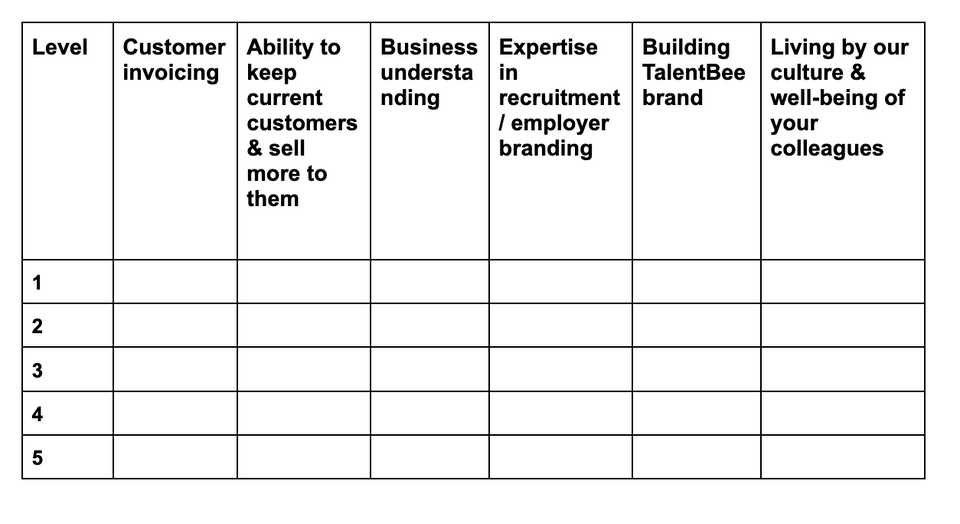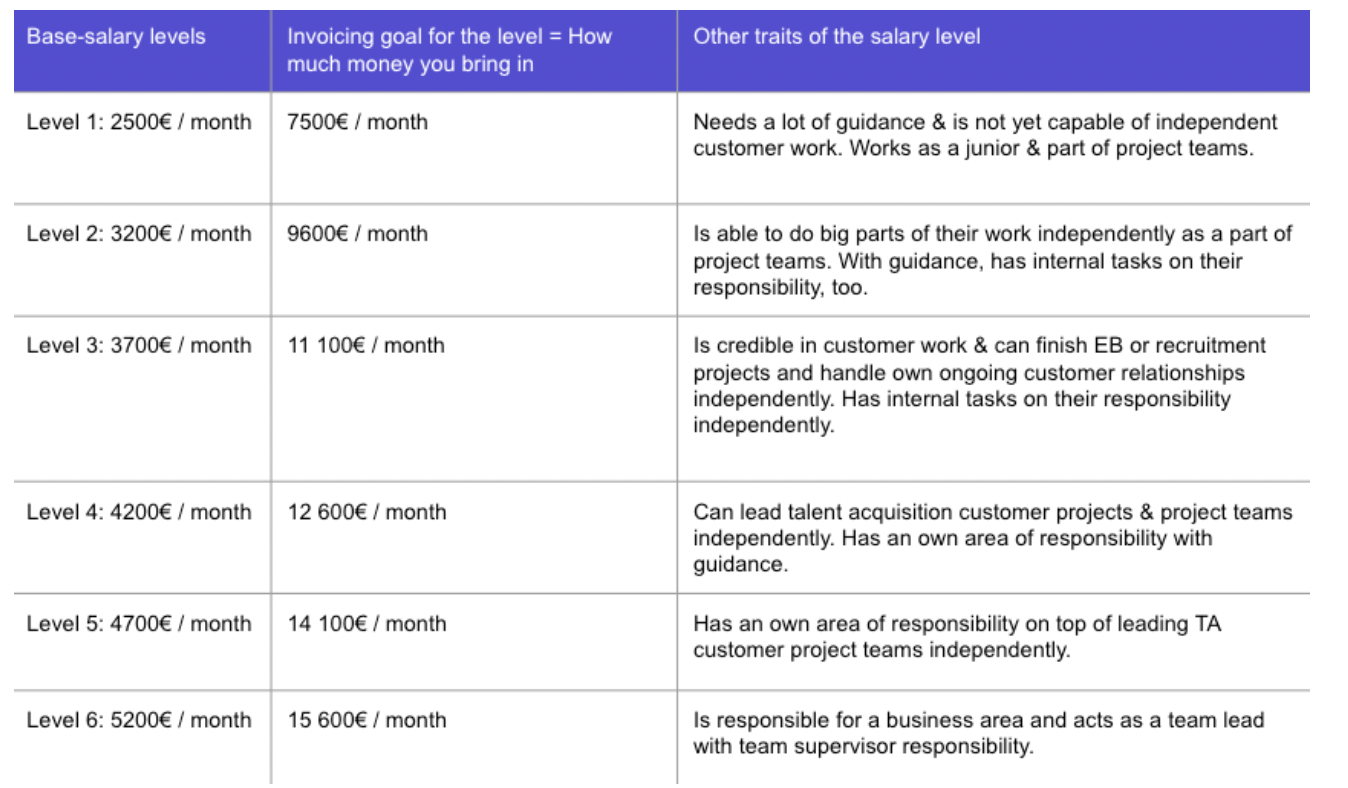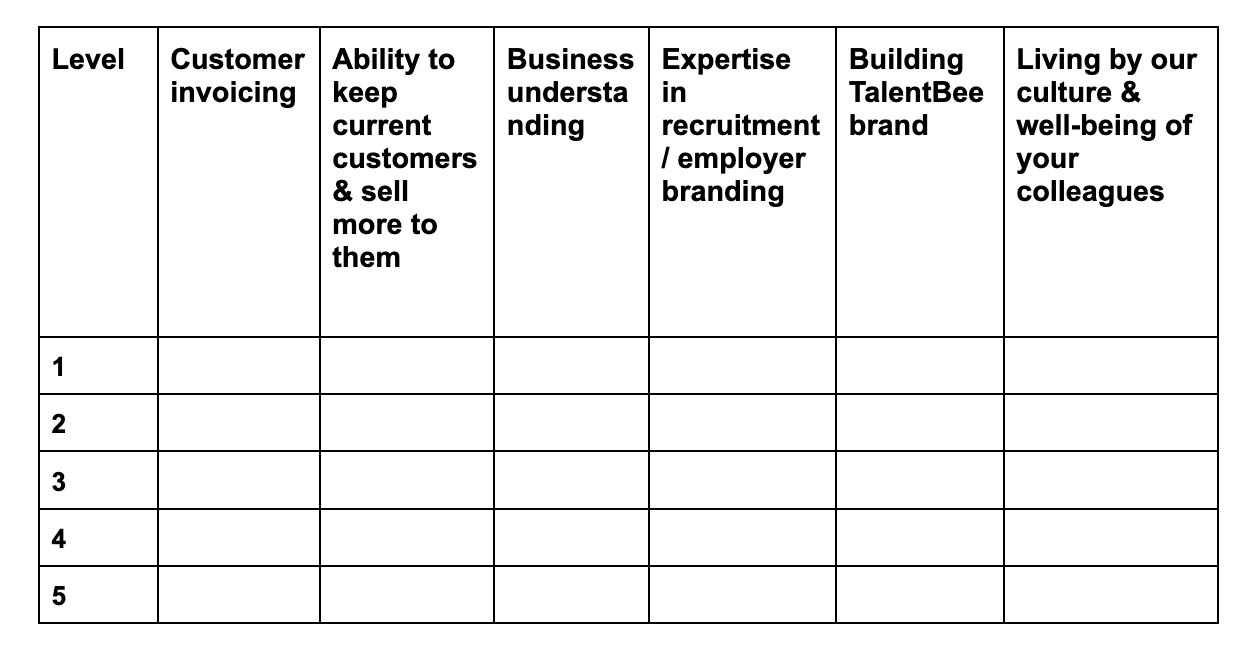Our salary-model 2.0

We believe in Transparency at TalentBee, so we have always shared our salaries and the numbers behind there.
We created the first version of our salary last autumn - tested it, and noticed some challenges with that one. So now it's time to take it to the next level.
Here is the old salary table:

There were a few fundamental problems we identified with this model:
- Our people felt that it was too focused only on customer invoicing.
- The other traits parts weren't clear enough for people.
- The steps were quite significant.
Why do we have open salaries & transparent model for defining wages?
Taking Transparency to another level is one of our core values.
When we founded TalentBee, we discussed what we didn't enjoy in the past working places. We noticed that there were a lot of common problems:
- People didn't know when they would get a raise or how to get a raise.
- People weren't paid for the value but for "seniority."
- People felt like they weren't paid equally.
- Didn't people understand the structure behind the numbers - How much can companies afford to pay salaries and why?
We worked on this model 2.0 by asking our employees for feedback on the attributes of the salary & combined them with our vision to come up with the first version.
After the first draft was ready, we collected some feedback and started to work on the model in more detail. In this case, performing the model in more fact means writing this article - We want to build things in public and get your feedback.
Defining the value moments
We started the project by finding out the value moments that should affect the salary and eventually ended up with six different attributes (these might still change!).
They are:
- Customer invoicing = How much money you are bringing in.
- Ability to keep current customers & sell more to them.
- Business understanding (focus on customers)
- Expertise in recruitment/employer branding
- Building TalentBee brand
- Living by our culture & well-being of your colleagues
In short, the model works like this:
- Give 1-5 points from each point
- Calculate the total score
- See your salary from the salary-table
Define what 1 - 5 points mean for different stages
Next, it's time to clearly define what having 1-5 points means. What is 1? What is 3? What is 5? For some, it's easier than for others, but let's see how it goes:
Customer invoicing (average from the past six months):
Level 1: 0 - 6000€ / month
Level 2: 6000 - 8000€ / month
Level 3: 8000 - 10 500€ / month
Level 4: 10 500 - 13 000€ / month
Level 5: + 13 000€ / month
Ability to keep current customers & sell more to them:
Level 1: There are many challenges with customer retention, and you cannot sell extra projects or increase the MRR for current customers.
Level 2: Most of your customers stay happy, and you have been able to sell 1-2 different projects to your current customers in the past six months. It would be best if you still had a lot of support in challenging situations.
Level 3: Your customers are typically happy, and you can sell extra projects to customers systematically. You can handle challenging situations with customers.
Level 4: Your customers are happy & you can systematically sell projects & increase MRR from them.
Level 5: Your customers are happy and have become advocates for our business. You are systematically selling projects & increase MRR to our customers from both EB and recruitment sides. You are building strong relationships with our customers' management team and opening doors to other business functions. Your past customers are also buying more from us.
Business understanding:
Level 1: You don't have experience or knowledge of SaaS businesses.
Level 2: You have experience in the SaaS business and can have simple discussions around SaaS business models.
Level 3: You can can have a good conversation with the SaaS founder about their product roadmap and future funding rounds.
Level 4: You know most of the SaaS terms and their meaning in a SaaS business. You can understand the line between what's going on in a business and how that affects talent acquisition. You can recommend a SaaS founder the order of people they should hire based on your understanding of their business.
Level 5: You understand SaaS business on a deep level - For example, you know an excellent CAC / LTV ratio for a SaaS company. You know how their MRR / Headcount should grow and what are the industry benchmarks. You can use these skills in both customer work and sales calls and systematically challenge founders around these topics.
Expertise in recruitment/employer branding:
Level 1: You need much support in day-to-day work as a talent acquisition professional.
Level 2: You can handle the essential work independently and need support in more challenging situations.
Level 3: You are already used to working with challenging situations and can solve most of them individually. You are an expert on what you do and can easily lead customers.
Level 4: Customer work & challenging situations are very familiar to you, and you can easily handle these. You are systematically building processes for TalentBee & customers around talent acquisition.
Level 5: Same as in 4 +, you can predict the challenging situation before they come, and you because there are fewer of those. You are supporting your team members in difficult situations.
Building TalentBee brand:
Level 1: You are not actively building the TalentBee brand and maybe sharing some LinkedIn posts occasionally.
Level 2: You are actively publishing content to LinkedIn and participate inin TalentBee's content production occasionally.
Level 3: You have a clear strategy for LinkedIn and use tools like Buffer to automate your content there. You systematically help produce content for TalentBee's channels.
Level 4: You produce different content formats for LinkedIn or other channels around TalentBee's strategic topics. You systematically help create content for TalentBee's media and develop ideas around these.
Level 5: You systematically bring insights from the audience & market on relevant topics. You publish unique content around TalentBee's strategic issues in multiple formats (like videos, podcasts, etc.), give keynote speeches, participate in in other webinars, podcasts, etc., and participate systematically in TalentBee's content production. By this, you can actively bring new potential customers to TalentBee's sales pipeline.
Living by our culture & well-being of your colleagues
Level 1: You are not living by our culture & our values - Instead, instead focusing on your success rather than being a team player.
Level 2: You know our values and keep them in mind when working and making decisions. If colleagues ask for help, you are there for them.
Level 3: You are helping to build TalentBee to become the best possible working place for talent acquisition professionals. You share if you see that we are having some challenges and are not afraid to talk about the hard things.
Level 4: You often ask colleagues how they are feeling and if you can help with something - If you notice that we are not going towards being the best possible workplace, you allow us to fix it to your best capability.
Level 5: You advocate for our culture - You make decisions based on our values and help your colleagues do so as well. You are organizing company-level events and are part of well-being ideas. You make sure that people around you have an excellent work-life balance.
It's hard to define the levels.
This was the first time I wrote down the five levels for each of these; these are my personal opinions. It was hard to come up with the levels, and I still see a lot of problems with them and them not being clear enough.
But that's why I'm writing this and making it public as well - You can help me and share your ideas on how to make them more transparent.
These founder's stories are also about internal communication because my team will be reading these from here the first time as well, and I will get feedback from them on these so we can take them to the next level 🙌
This is the salary matrix.
Now that we have defined all the levels, it's time to build the salary Matrix, which is something like this:

The minimum number of points is 6 (if you get to level 1 from each), and the maximum is 30 points (if you get five from each level).
So let's create a salary level:
6-7 points = 2000€ / month
8-9 points = 2500€ / month
10-11 points = 2750€ / month
12-13 points = 3000€ / month
14-15 points = 3250€ / month
16 - 17 points = 3500€ / month
18-19 points = 3750€ / month
20-21 points = 4000€ / month
22-23 points = 4250€ / month
24-25 points = 4500€ / month
26-27 points = 4750€ / month
28-29 points = 5000€ / month
30 points = 5500€ / month
So let's take an example so you see how it works. A person gets:
Level 2
Level 3
Level 2
Level 4
Level 3
Level 5
This means the total points are 2+3+2+4+3+5 = 19 points = 3750€ / month.
FAQ
When we first presented the model to our team, we got some great questions.
Question 1: Can my salary go down?
Answer 1: No. Your points could go down, of course - Let's say you can't bring in invoicing or sell more to customers. Your salary will remain the same, and we will work together to get you back on track for your next raise.
Question 2: Who gives the points? Me, my team lead, or someone else?
Answer 2: Together. We discuss these topics on our monthly 1to1, so no surprises are coming, and both parties agree on where we are with the number. If in some cases, the team lead & the person disagree on the score, we have a few things we can do: Ask your colleagues what they think and ask your customers what they believe. The key here is to have a a clear definition for each level to make it as easy as possible.
This might seem quite complex - Why not just a regular salary model?
This wasn't a question from our team but something you might be thinking. Why don't we pay someone 3,5k and someone 4k without any fancy scorecards?
We could do that, but there are a few main reasons why we want to do it this way:
- We want our people to know precisely what is expected from them to get a raise & how they can affect that.
- We want people to earn by their value - Not only the working experience they have.
- Our promise to our people is that they learn a lot about running a business - salaries are a big part of that, and we want our people to know more about how salaries are structured and what things affect those.
We have a salary discussion with our people every six months - No need to ask for a salary discussion with your boss.
Please share your thoughts around the topic!